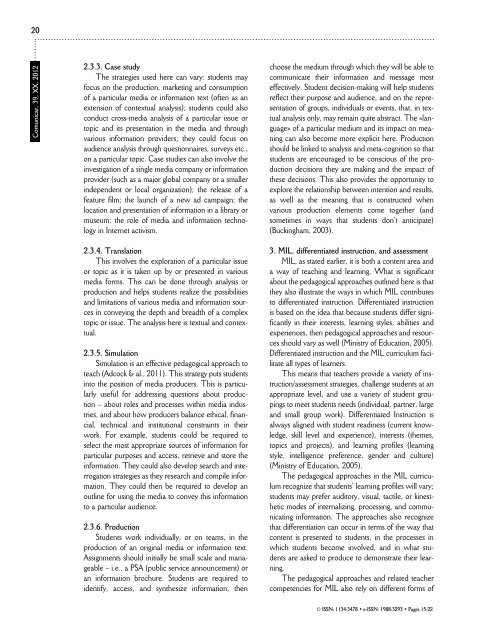Comunicar 39-ingles - Revista Comunicar
Comunicar 39-ingles - Revista Comunicar
Comunicar 39-ingles - Revista Comunicar
Create successful ePaper yourself
Turn your PDF publications into a flip-book with our unique Google optimized e-Paper software.
20<strong>Comunicar</strong>, <strong>39</strong>, XX, 20122.3.3. Case studyThe strategies used here can vary: students mayfocus on the production, marketing and consumptionof a particular media or information text (often as anextension of contextual analysis); students could alsoconduct cross-media analysis of a particular issue ortopic and its presentation in the media and throughvarious information providers; they could focus onaudience analysis through questionnaires, surveys etc.,on a particular topic. Case studies can also involve theinvestigation of a single media company or informationprovider (such as a major global company or a smallerindependent or local organization); the release of afeature film; the launch of a new ad campaign; thelocation and presentation of information in a library ormuseum; the role of media and information technologyin Internet activism.choose the medium through which they will be able tocommunicate their information and message mosteffectively. Student decision-making will help studentsreflect their purpose and audience, and on the representationof groups, individuals or events, that, in textualanalysis only, may remain quite abstract. The «language»of a particular medium and its impact on meaningcan also become more explicit here. Productionshould be linked to analysis and meta-cognition so thatstudents are encouraged to be conscious of the productiondecisions they are making and the impact ofthese decisions. This also provides the opportunity toexplore the relationship between intention and results,as well as the meaning that is constructed whenvarious production elements come together (andsometimes in ways that students don’t anticipate)(Buckingham, 2003).2.3.4. TranslationThis involves the exploration of a particular issueor topic as it is taken up by or presented in variousmedia forms. This can be done through analysis orproduction and helps students realize the possibilitiesand limitations of various media and information sourcesin conveying the depth and breadth of a complextopic or issue. The analysis here is textual and contextual.2.3.5. SimulationSimulation is an effective pedagogical approach toteach (Adcock & al., 2011). This strategy puts studentsinto the position of media producers. This is particularlyuseful for addressing questions about production– about roles and processes within media industries,and about how producers balance ethical, financial,technical and institutional constraints in theirwork. For example, students could be required toselect the most appropriate sources of information forparticular purposes and access, retrieve and store theinformation. They could also develop search and interrogationstrategies as they research and compile information.They could then be required to develop anoutline for using the media to convey this informationto a particular audience.2.3.6. ProductionStudents work individually, or on teams, in theproduction of an original media or information text.Assignments should initially be small scale and manageable– i.e., a PSA (public service announcement) oran information brochure. Students are required toidentify, access, and synthesize information, then3. MIL, differentiated instruction, and assessmentMIL, as stated earlier, it is both a content area anda way of teaching and learning. What is significantabout the pedagogical approaches outlined here is thatthey also illustrate the ways in which MIL contributesto differentiated instruction. Differentiated instructionis based on the idea that because students differ significantlyin their interests, learning styles, abilities andexperiences, then pedagogical approaches and resourcesshould vary as well (Ministry of Education, 2005).Differentiated instruction and the MIL curriculum facilitateall types of learners.This means that teachers provide a variety of instruction/assessmentstrategies, challenge students at anappropriate level, and use a variety of student groupingsto meet students needs (individual, partner, largeand small group work). Differentiated Instruction isalways aligned with student readiness (current knowledge,skill level and experience), interests (themes,topics and projects), and learning profiles (learningstyle, intelligence preference, gender and culture)(Ministry of Education, 2005).The pedagogical approaches in the MIL curriculumrecognize that students’ learning profiles will vary;students may prefer auditory, visual, tactile, or kinestheticmodes of internalizing, processing, and communicatinginformation. The approaches also recognizethat differentiation can occur in terms of the way thatcontent is presented to students, in the processes inwhich students become involved, and in what studentsare asked to produce to demonstrate their learning.The pedagogical approaches and related teachercompetencies for MIL also rely on different forms of© ISSN: 1134-3478 • e-ISSN: 1988-3293 • Pages 15-22
















